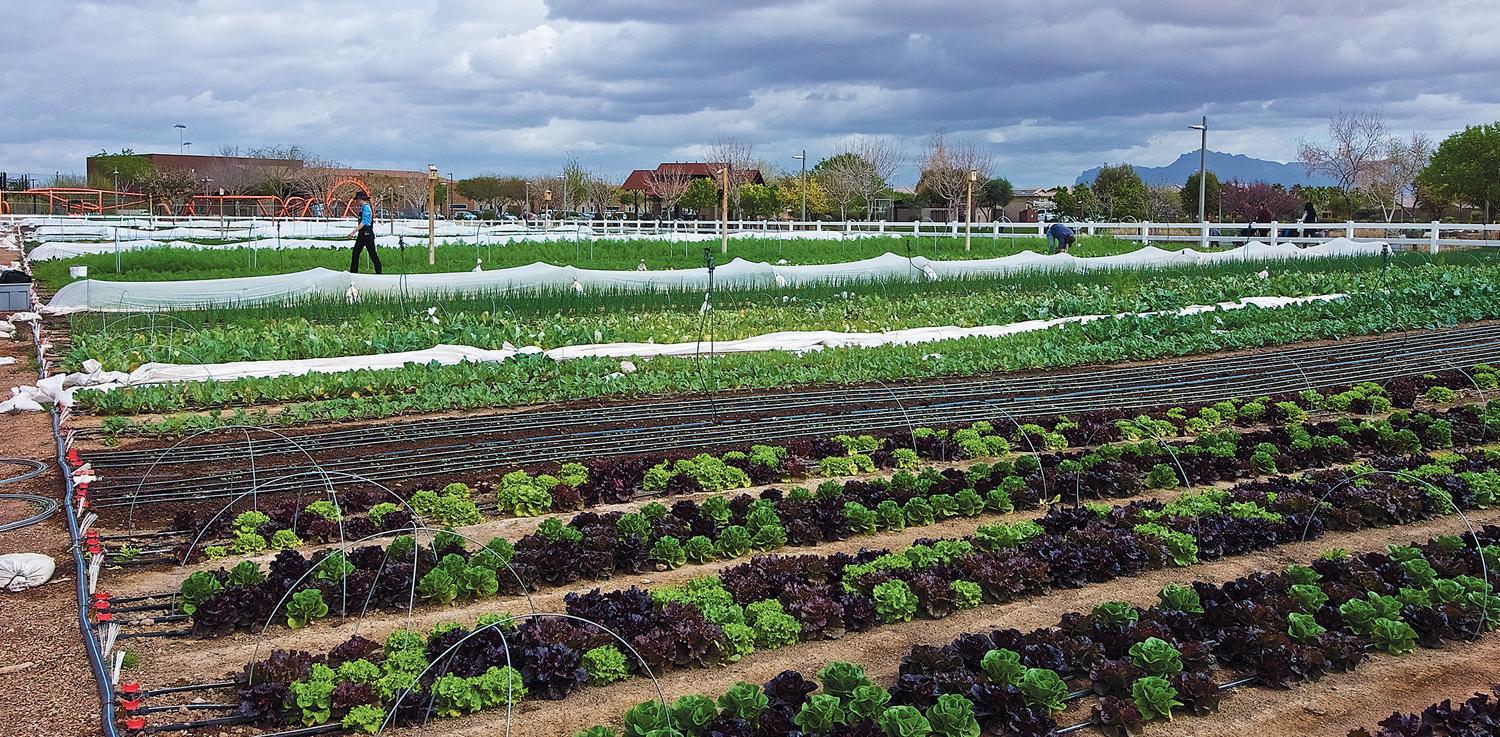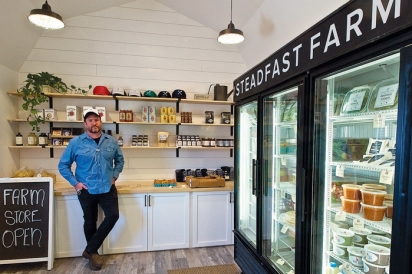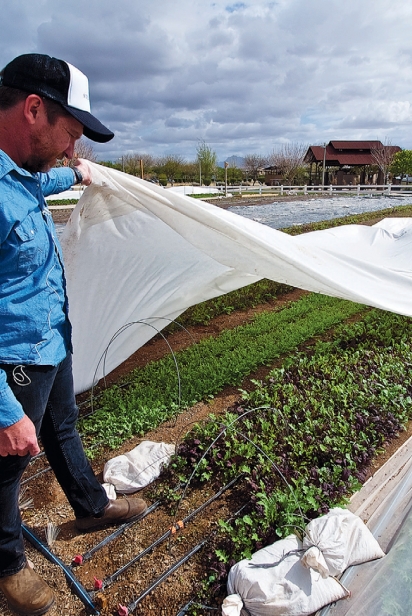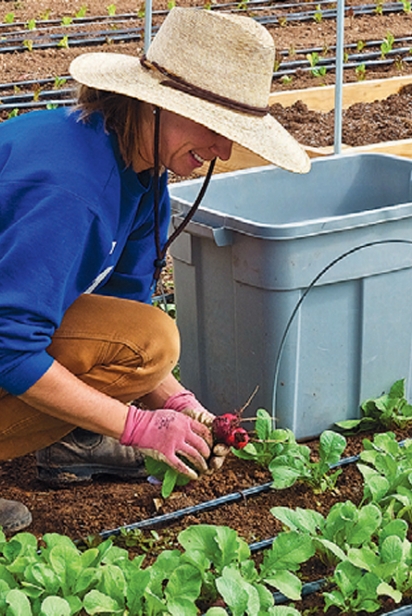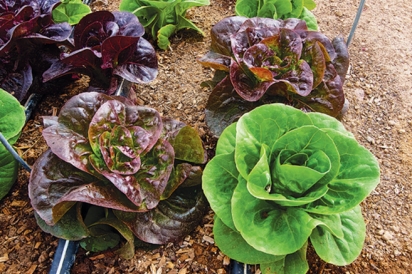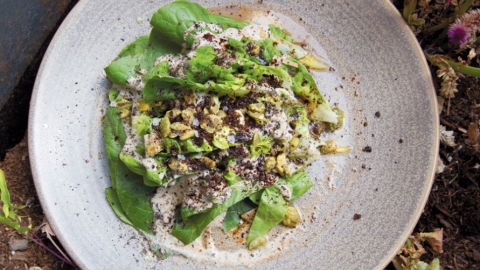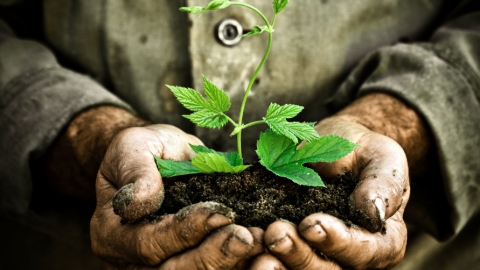Steadfast Farm Agrihood: An Idea Worth Replicating
IF YOU LOOK at Steadfast Farm on a Google map you see a tiny speck, surrounded by a park with green grass, a playground, a lake and an outdoor stage. This is surrounded by a geometric array of houses and streets stretching to the desert edge of east Mesa, Arizona.
Driving to the farm, you’ll wind through traffic lights, boulevards and apartments, coming to park in front of a micro farm bordered by neat outbuildings, greenhouses and pristine white fencing with a welcoming farm gate. Looking around, it’s stunningly perfect: prim lined beds of flowers and vegetables, birds singing, ducks quacking. I catch the aroma of lavender. It’s a beautiful spring day. Erich Schultz, the proprietor of Steadfast Farm, welcomes me with a smile and handshake. (Vaccinated now, I can revert to actual physical contact.)
Schultz calls his farm an “agrihood, a better way of doing suburbia.” The neighbors love it. Here they are, jogging by, and here come a couple of moms with baby carriages on a stroll. Steadfast Farm is an amenity in the sprawling Eastmark development, where residents can experience the farm, benefit from easily accessible healthy food and not be tied to producing it themselves. Schultz explains that an agrihood is a mixed development combining real estate and farms, integrating agriculture into a residential neighborhood. It’s a national trend driven by the local food movement. The developers of this property are Brookfield Residential Properties Inc., one of the largest in North America, and Valley-based DMB Associates Inc. When they planned this community, they came to Schultz for his expertise.
Schultz started his career in urban farming by managing the Agritopia Farm, 22 acres preserved within a mixed family housing development in Gilbert. Now he is running Steadfast Farm with one acre in row crops, two greenhouses and one grow room for microgreens. It’s precision farming, full of ingenious solutions developed, tested and refined over Schultz’s 10 years of agrihood experience (see sidebar). It’s his most profitable farm yet—an amazing achievement for a small plot—because of a relentless focus on efficiency, continuous production, high-quality and high-value crops and cost control.
Steadfast Farm supports 100 community- supported agriculture (CSA) harvest subscription program shares, sells at three farmers markets and delivers to 20 local restaurants. The farm store is open three days a week (moving to seven) and the Steadfast Coffee truck serves espresso, pastries and breakfast tacos.
Schultz firmly believes in making every square foot of the operation profitable by maximizing production. He says that farmers and farmworkers should expect fair pay, vacation, sick leave and health insurance. When Schultz was at Agritopia, he farmed vegetables, orchards, heirloom grains, cows, ducks, chickens, turkeys, sheep, pigs and bees. He says, “I worked all the time and really learned a lesson about capping my dreams.” His subsequent farming enterprises got progressively smaller.
Steadfast is his smallest farm yet but it generates the most revenue. In 2020 the pandemic influenced more people to buy local, and it was the farm’s biggest year ever. Schultz says that 2021 is starting out as an even better year.
Schultz chooses crops that he knows can make money, crops that mature quickly with high yields that don’t take up a lot of space. Salad greens produce 100 pounds in a solidly packed 30-inch wide by 100-foot long bed in 45 days. Adorable baby heads of lettuce bring in even more income in the same space. We visited one greenhouse where he works successive plantings of squash, cucumbers, tomatoes, peppers, onions and kohlrabi in tune to seasonal flow and high demand.
Schultz relies on three labor-saving and soil-preservation techniques on the farm:
1 Minimum tillage: I always thought gardens needed a good deep digging and turning to bring up nutrients. Current research, pioneered by organic farmers, shows this to be completely wrong. Deep digging destroys decaying organic matter root systems and resident soil organisms; it compacts the soil and it brings up underlying weed seeds.
2 Composting in place: After harvesting lettuce, the bed is covered with black plastic, allowing the remaining plant matter to decompose and enrich the soil.
3 Flame Weeding: Carrots are slow to germinate, so fast-growing weeds sprout first. One pass with the Flame Weeder, a five-burner blow torch on wheels, and weed seedlings are scorched out of existence while the carrot seeds lie protected under the soil.
With all this production, Schultz has not forgotten environmental values. He says, “Three years ago this was scraped-down dead soil, as disturbed as it could be.” Using compost, humates, earthworms and other organic bio-intensive methods, the soil has been restored to productive health. It’s alive with beneficial bacteria and organic matter and produces extremely healthy, disease resistant, fast growing, nutrient rich vegetables. The farm is watered with water-conserving drip tape and kept cool with misting sprinklers.
Schultz promotes biodiversity with bird nesting sites, bat houses and pollinator-attracting plants. Pests are treated with organics like neem oil, pyrethrum, BT (Bacillus thuringiensis) and beneficial nematodes. Sturdy fencing discourages ground squirrels. (Schultz bristles when I mention the noisy grackles; they like to pull up seedlings. They are a challenge, but I enjoy their vocal cackling.)
For the future Schultz is thinking about maximizing production through the Phoenix summer heat blast. It is a challenge to grow year-round. Anyone who has gardened knows that lettuce turns bitter and bolts to seed in the heat. But Schultz has produced lettuce throughout the desert summer using shade cloth and misting micro sprinklers that create, essentially, an evaporative cooler.
With the deep decline in Valley farmland, the Steadfast agrihood is an idea worth replicating. Every development, every neighborhood, needs a micro farm. The ingenuity of small growers like Schultz is creating a new environmentally balanced agriculture and finding ways to bring it home no matter where you live—especially in the big city.
Ingenuity in Action on the Farm
We start our tour of Steadfast Farm looking at Schultz’s collection of high-efficiency, low-tech farm tools. Schultz first shows off his BCS walk-behind tractor, a small-scale tool designed to work the soil. To harvest loose leaf lettuce, he uses a Quick Cut Greens Harvester that “combines a car wash with a turkey carving knife.” It’s powered by a cordless drill that cuts salad greens and gently tumbles them into a hamper. “We used to cut salad greens with a pocket knife or scissors. We produce 400—600 pounds of salad mix a week and this tool makes it happen,” says Schultz.
Schultz starts seedlings in paper chain pots, a sort of origami honeycomb of paper pockets that are filled with soil, seeded and held in trays for germination. The seedlings are planted using a Paper Pot Transplanter, a non-motorized system enabling one person to plant 800 feet of row in 10 minutes. The paper pot motto: “What used to take hours, now takes minutes.”
Have you ever planted carrots? Carrot seeds are difficult. They are tiny and clump together, resulting in time-consuming thinning after they sprout. It’s very slow work. Schultz uses a precision seeder that “allows for accurate singulation for a range of crops.” The Jang seeder rolls out up to six rows of carrot seeds in one pass, precisely spaced. Schultz has condensed his planting system onto plasticized “crop cards” for his workers, detailing how to set up the Jang for each planting—an example of the efficient systems he uses to quickly train workers.
This is not the end of the cool stuff going on. I am blown away by all the high-efficiency, low-tech, boot-strapped, farm-rigged, ingenious, resourceful and clever solutions—like the seed germination chamber built from a freezer. Schultz says, “It’s just an insulated box outfitted with a light bulb and a mini electric Crock-Pot to keep the temperature and humidity high, producing perfect conditions to speed up germination and to keep the garden beds in maximum production.”
If you take a storage shed, insulate the heck out of it with foil-backed foam insulation, outfit it with a window air conditioner and a CoolBot controller, voila! you have Steadfast’s walk-in cooler, a truly farm-rigged tool. The CoolBot is a small device that uses sensors, a heating element and programmed micro controller to redirect the air conditioner to cool down to 34°F. CoolBots were invented in 1999 by a small farmer who needed affordable cold storage.
I also love the vegetable table wash area, neatly assembled from a livestock water tank using a high-pressure washing nozzle to knock dirt off root vegetables and a Jacuzzi bubbler to gently tumble delicate salad greens. After washing, the greens are spun in a washing machine outfitted with a perforated food-grade bucket then dried with box fans.
Schultz doesn’t take the credit for these examples of extreme creativity. Instead he credits an information sharing network of clever boot-strapping farmers for coming up with these innovative solutions.


